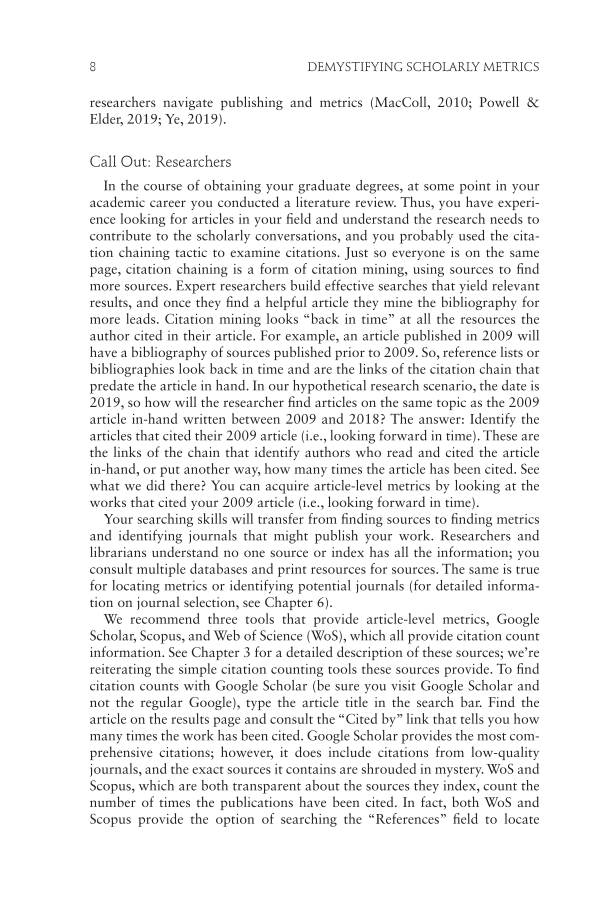8 DEMYSTIFYING SCHOLARLY METRICS researchers navigate publishing and metrics (MacColl, 2010 Powell & Elder, 2019 Ye, 2019). Call Out: Researchers In the course of obtaining your graduate degrees, at some point in your academic career you conducted a literature review. Thus, you have experi- ence looking for articles in your field and understand the research needs to contribute to the scholarly conversations, and you probably used the cita- tion chaining tactic to examine citations. Just so everyone is on the same page, citation chaining is a form of citation mining, using sources to find more sources. Expert researchers build effective searches that yield relevant results, and once they find a helpful article they mine the bibliography for more leads. Citation mining looks “back in time” at all the resources the author cited in their article. For example, an article published in 2009 will have a bibliography of sources published prior to 2009. So, reference lists or bibliographies look back in time and are the links of the citation chain that predate the article in hand. In our hypothetical research scenario, the date is 2019, so how will the researcher find articles on the same topic as the 2009 article in-hand written between 2009 and 2018? The answer: Identify the articles that cited their 2009 article (i.e., looking forward in time). These are the links of the chain that identify authors who read and cited the article in-hand, or put another way, how many times the article has been cited. See what we did there? You can acquire article-level metrics by looking at the works that cited your 2009 article (i.e., looking forward in time). Your searching skills will transfer from finding sources to finding metrics and identifying journals that might publish your work. Researchers and librarians understand no one source or index has all the information you consult multiple databases and print resources for sources. The same is true for locating metrics or identifying potential journals (for detailed informa- tion on journal selection, see Chapter 6). We recommend three tools that provide article-level metrics, Google Scholar, Scopus, and Web of Science (WoS), which all provide citation count information. See Chapter 3 for a detailed description of these sources we’re reiterating the simple citation counting tools these sources provide. To find citation counts with Google Scholar (be sure you visit Google Scholar and not the regular Google), type the article title in the search bar. Find the article on the results page and consult the “Cited by” link that tells you how many times the work has been cited. Google Scholar provides the most com- prehensive citations however, it does include citations from low-quality journals, and the exact sources it contains are shrouded in mystery. WoS and Scopus, which are both transparent about the sources they index, count the number of times the publications have been cited. In fact, both WoS and Scopus provide the option of searching the “References” field to locate
Document Details My Account Print multiple pages
Print
You have printed 0 times in the last 24 hours.
Your print count will reset on at .
You may print 0 more time(s) before then.
You may print a maximum of 0 pages at a time.





































































































































































































































